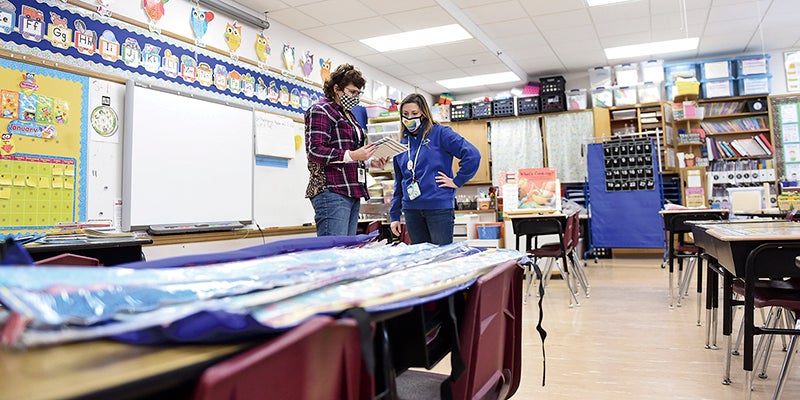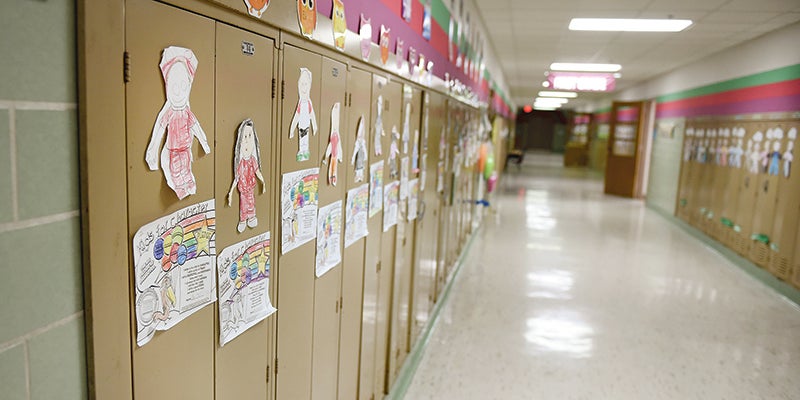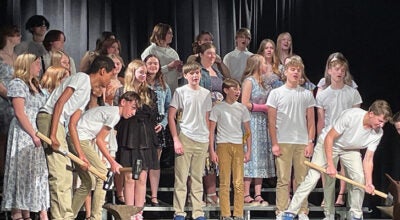The COVID school year set to resume Monday
Published 7:01 am Saturday, January 9, 2021

- Banfield first grade teacher Maegan Siebe, right and Mind, Body, Soul teacher Susan Conway confer in Siebe’s classroom Friday as they prepare for a return to classrooms by students on Monday. Eric Johnson/photodesk@austindailyherald.com
|
Getting your Trinity Audio player ready...
|
Only in an age dominated by a pandemic can school districts look forward to heading back to school twice in one school year.
And yet, here we are.
Austin Public Schools will return to hybrid learning about a month-and-a-half after the district decided to shift back into distance learning for the remainder of the year with a goal to return to hybrid by Jan. 4.
However, as COVID-19 numbers remained high in the county, APS opted to push that back to Jan. 11.
“The numbers across the state and specifically here in Mower have really come down,” said Superintendent David Krenz. “It really is going to be helpful to us to keep our teachers in the classrooms and students coming to school.”
APS, along with schools across the state, were highly optimistic when school resumed in September through hybrid learning. Last spring was a trial by fire when schools were forced to transition on just a few days notice.
While things certainly are not back to normal, the process of distance learning and hybrid learning has been made easier thanks to lessons learned. Schools and staff were more prepared and technology garnered through COVID relief dollars has given APS an edge when the time came to get back to distance learning.
Individual schools saw that improvement this time around. On Friday, teachers and staff of Banfield Elementary were preparing for a return of students on Monday. Banfield Principal Jeff Roland said it has been very anticipated.
“It’s been tough on teachers,” Roland said. “But they’ve pulled through and are much better prepared.”
Families in the district have reflected that sentiment.

Lockers remain decorated at Banfield Elementary Friday, waiting for their students to come back. Eric Johnson/photodesk@austindailyherald.com
“We’ve had a lot of good comments from families and have heard from kids who want to come back,” Roland said.
The level of preparedness has been the work on an ongoing effort that goes back to the beginning of the school year.
“We began planning right away once school started in case of this eventuality,” Krenz said. “We have more diversity in software to reach more students.”
That has been another aspect trending upward. The tech has lent itself to reaching more students and engaging them longer.
“We just had a minor number of students not engaged this time around, where in the spring it was a lot larger number,” Krenz said. “It had to do with the way teachers engaged students and the tools we had to engage students.”
“The teachers are a bit more experienced in using See-Saw and the telecommunications,” Roland echoed.
More students were also able to spend more time within buildings despite it being distance learning, including special needs and ESL students.
“Yes they had a schedule, but we were able to do that and kept those kids on track,” Krenz said.
Krenz also said that the staff of APS, from administration to the teachers to food service to custodial, are continuing to set the bar higher in terms of how they are approaching the challenges laid out in front of them.
“It’s just amazing,” he said. “This last month, again, the willingness and the ingenuity of the staff, all of them from teachers to food service to custodial to secretaries — they stepped up.”
What remains to be seen, however, is just how much of a toll the COVID-19 pandemic has taken on student’s individual education. In December, Corey Haugen, director of Research Evaluation and Assessment, reported a higher than normal failure rate within the district. That was particularly evident in students still choosing distance learning, even when hybrid learning was in effect.
Distance learning students are making their way back to classrooms, Roland said, as Banfield has seen its distance learners cut in half. How this school year will be impacted in terms of student grades has yet to be determined.
“The end piece of that will be determined down the road when looking at assessments,” Roland said. “More of that is the social and emotional toll it takes.”
Roland likened it to snow days where kids look forward to one or two snow days, but “This is a continuous bunch of snow days. They are looking forward to coming back.”
The district’s goal is hopefully to get through to Spring Break in March, but a lot of that will be determined on vaccine roll-out.
In talks with Mayo Clinic Health System-Austin, the district knows they aren’t on the first tier of vaccine recipients, but instead they are simply hoping it’s sooner rather than later.
“The crucial component will be the vaccine; how soon can we get the vaccine rolled out?” Krenz said. “If things stayed the same without vaccines, the number of cases and quarantines rises. If we can get the vaccine out and get our people vaccinated, that will be critical.”





